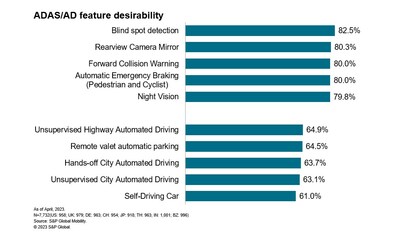Consumers Desire Automated Safety over Self-driving Technology, according to S&P Global Mobility
Survey of 8,000 car shoppers worldwide shows semi-autonomous driving features are still missing that crucial trust factor, whereas automated safety features are gaining traction and acceptance.
According to a spring 2023 S&P Global Mobility consumer survey, trust and familiarity remain barriers to car shoppers adopting autonomous driving technology. Put simply, as the amount of vehicle automation increases, consumer desire decreases.
Each of the five most-desired ADAS features improves safety. Blind spot warning ranks as the most desired feature, wanted by
"Exposure is helping to drive much of the desirability for these features," said Yanina Mills, senior technical research analyst at S&P Global Mobility.
However, while autonomous driving features add convenience by reducing the tedium of driving, they fall well short of ADAS safety features when it comes to buyer desirability. "Safety versus convenience operate in two different ballparks of interest," according to Brock Walquist, senior technical research analyst at S&P Global Mobility.
By contrast, consumer experience with self-driving is essentially non-existent, further inhibiting its desirability. Whereas many automated safety features poll in the 80th percentile range, only
But increased capability doesn't increase buyer desire. Consumers still prefer automated driving features where the driver maintains more control. Only
Among those polled,
Optimism about self-driving cars remains cautious at best – bearing in mind that "consideration" is high up the purchase funnel before purchase papers get signed. If OEMs want to convince more buyers that autonomous driving systems are worthwhile, they need to better communicate their benefits, Mills said.
Consumer sentiment is different across regions. Consumers in Mainland China, for example, have consistently shown the highest desirability scores for self-driving technology, while consumers in the US,
"Consumers don't exactly know how it is going to work. There is confusion," Mills said. "They are asking, 'Is it self-driving, or is it just going to help me a bit and I still have to focus?'"
The evolving nature of automated driving poses challenges – both to OEMs who want to sell these systems, and to consumers who are weighing their purchase. Automakers will need to better define the benefits of autonomy to improve its desirability to consumers.
Please visit this link for further details on the survey
For the full S&P Global Mobility Report, subscribe here
About S&P Global Mobility
At S&P Global Mobility, we provide invaluable insights derived from unmatched automotive data, enabling our customers to anticipate change and make decisions with conviction. Our expertise helps them to optimize their businesses, reach the right consumers, and shape the future of mobility. We open the door to automotive innovation, revealing the buying patterns of today and helping customers plan for the emerging technologies of tomorrow.
S&P Global Mobility is a division of S&P Global (NYSE: SPGI). S&P Global is the world's foremost provider of credit ratings, benchmarks, analytics and workflow solutions in the global capital, commodity, and automotive markets. With every one of our offerings, we help many of the world's leading organizations navigate the economic landscape so they can plan for tomorrow, today. For more information, visit www.spglobal.com/mobility.
Media Contact:
Michelle Culver
S&P Global Mobility
248.728.7496 or 248.342.6211
Michelle.Culver@spglobal.com
![]() View original content to download multimedia:https://www.prnewswire.com/news-releases/consumers-desire-automated-safety-over-self-driving-technology-according-to-sp-global-mobility-301852462.html
View original content to download multimedia:https://www.prnewswire.com/news-releases/consumers-desire-automated-safety-over-self-driving-technology-according-to-sp-global-mobility-301852462.html
SOURCE S&P Global Mobility









